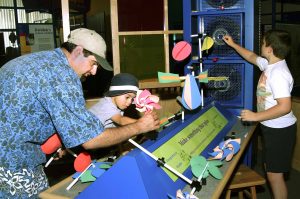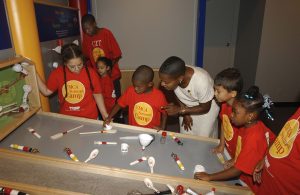
Al Nappo and his son, Max, age 3, experiment and explore with Whirligigs in the Invention Playhouse.
Smithsonian Photo by Richard Strauss
What do we really mean by Parent Support and Engagement? Over the past several weeks Rebecca Herz, blogger at Museum Questions, and I have been conversing about philosophies of exhibit design, play, and learning in children’s museums. Two of her recent posts posts (here and here) have examined the history and impact of children’s museums. I responded here on Museum Commons by discussing my experience in the late 1980s and early 1990s with the Playspace exhibit at the Children’s Museum in Boston. Our exhibition development team from the American Psychological Association and the Ontario Science Centre studied Playspace, built a prototype for the Traveling Psychology Exhibition, and then toured the exhibition to 14 plus science centers all over the US from 1992 to the end of the decade. I’m not sure there is research on this, but I believe that this touring exhibition had at least some impact on the development of play-based spaces in children’s museums around the country. You can find more about the Psychology Exhibition and its child development section, Playspace, elsewhere on this blog.
Today I’d like to respond to Rebecca’s latest post, “How Do We Engage Parents in Children’s Museums,” with some further thoughts on the topic of adult-child interactions in museums. (I should also mention that I will try to use “adult” or “caregiver” instead of “parent” when I can, knowing that the child-adult groups who come to museums may have a variety of relationships with one another.)
Rebecca writes, “When a parent arrives at the museum with children, our hope (the hope of children’s museum professionals) is that they will play with and teach their children.” But my experience has led me to think that
Actual physical engagement between adults and children need not always be the goal of play-based exhibits, especially those for toddlers and younger children.
Articles on this site (see Psychology Exhibition) indicate that Playspace was created as “a space where adults can learn about child development by: watching children at different stages of development as they play; talking with other adult visitors and with staff; reading the exhibit’s supporting materials.” Playspace was designed` to reinforce for adults that even the youngest children, by way of human evolution, are learning all the time. Elaborate toys are unnecessary; the simplest and least expensive materials can provide rich learning experiences because children are born with wonderfully complex and able brains, sensations, emotions, and bodies. Playspace was equipped with simple and (mostly) inexpensive materials that caregivers could acquire for the home: mirrors, water, sand, clay, safe climbing structures, plastic containers, pots and pans, small tables and chairs, etc–and children needed no encouragement to move, climb, pretend, taste, smell, and touch. (This is why stringent sanitary and safety measures were always part of staff training, and why we went through a lot of bleach at the end of each day.) While most adults with infants stayed close to them on the floor as they peered into mirrors, rolled, or crawled, adults with toddlers sat on the benches around the space, sharing thoughts with other adults, talking with staff, or reading the child development materials provided. All of this–kids learning while exploring and parents learning by observing or interacting–was the intended goal of Playspace.
For children of reading age and above, I have found that Minda Borun’s research on specific design characteristics that encourage multi-generational interaction and learning is very useful. But even for older children, my training at the Children’s Museum leads me to favor children’s exhibits that allow for exploration and open-ended play. In Rebecca’s examples, I think that telling a child to “keep milk cold in the refrigerator,” provides a useful fact for playing grocery store. However, for kids who are constructing marble rolling pathways, I’d prefer it if adults let them figure it out for themselves, even if it takes a long time and they don;t quite get it on the first few tries. I have spent lots of time biting my tongue as I watch adults “finish” or “correct” a child’s project to make it come out right, rather than allowing tinkering and making mistakes.

Magnetic Ramp
Visitors to Invention at Play are invited to use everyday objects in new ways and work together to create trackways for a rolling ball on a magnetized ramp.
Smithsonian Photo by Terry McCrea
Of course, my observations about open-ended play have been culturally shaped by my middle class European-American background. So, my second observation about Rebecca’s hope that parents will play with and teach their children at the museum is:
Adult-child interactions in any society are culturally/ethnically shaped; given the cultural diversity of the US, there is not necessarily a single model that will be universally effective in encouraging family engagement in exhibitions.
There is a growing body of research (I’m familiar with work in the US and the UK) on ways in which exhibition design in museums reflects the culture and assumptions of Europeans and European-Americans. Researchers are assessing, among other factors, cultural understandings of space, the nature of learning in museums, the kinds of exhibits that promote learning, and the relationship of play to learning. The child development scholar Suzanne Gaskins, professor emeritus at Northeastern Illinois University, has published a number of articles over the past 10 years that examine the differing ways in which European American, African American, and Latino American families interact with each other and with exhibits in a children’s museum. The focus of her work has been at the Chicago Children’s Museum, but her research has also been shaped by her studies of family interactions in other Latin American cultures. While her study sample is small, other research such as that of Emily Dawson in “Not Designed for Us,” reinforces the idea that both the design of museum physical spaces and the exhibits within them reflect powerful and deeply held assumptions about what is the “correct” museum experience. Yet these assumptions reflect perspectives that:
- are primarily a European and Euro-American cultural construct
- are viewed as normative and thus are not understood as culturally conditioned
- may create a lack of comfort in visitors with other cultural backgrounds
- may work against diverse types of family interaction and understandings of what is of value in a museum visit.
As Gaskins states in Children’s Learning in Museums with their Parents
“When a museum makes a commitment to supporting the children’s learning in family groups, they also need to make a commitment to understanding more fully what families expect from their visit and how families organize their social interaction. The most accepted model of social learning in museums is a sociocultural one, built on the theory of Vygotsky, which emphasizes the co-construction of meaning through conversation… Because this model largely matches the understandings of European-American parents about play, learning, and social roles, many of the visitors that come to museums act in the way that museums expect families to act. But our research demonstrates that not all visitors will be working with the same model of family learning. We have shown that for two cultural groups, African-Americans and Latinos, their model of family learning is significantly different from that of the museum. While they may share with more traditional museum visitors the expectation of experiencing novel, interesting, and fun activities during their museum visit, they bring with them cultural understandings about how children learn and their role in that learning that will lead them to interact in ways that are at odds with the expectations of the museum. When families do not display the kind of behavior the museum expects them to, museum staff are often judgmental. Not recognizing that there can be more than one cultural model for how families learn, the staff’s first inclination is to “teach” parents and children how they “should” act in their museum. But families do not act as they do simply out of ignorance (although some families may not be as used to attending museums as others). Rather, their behavior is organized by cultural models that are habitual and complex; they cannot be changed by a brief orientation or signage throughout the museum. More importantly, these visitors do not want to change the ways they are used to interacting together. They value their cultural understandings; they enjoy experiencing the museum through the lens they are used to. Rather than trying to change visitor behavior, museums should put their effort into understanding more about the cultural models of family learning that different groups of visitors bring to the museum and how they affect visitors’ engagement with the exhibits and programs offered by the museum. Then, they can use that knowledge to design (or redesign!) their museum experiences in ways that support a broader range of ways of interacting and learning.”
Design suggestions based on Gaskins’ research.
- “Information should be presented in ways that are sometimes directly content driven and sometimes exploratory.
- Some activities should be open-ended, some goal-oriented
- Experiences should be available to individuals (of varying ages) and to groups working together (including large groups).
- The physical space should provide proximal seating for parents who want to collaborate or teach, but also provide distal seating for those who want to observe or witness.
- The more we know about the different ways that families learn together, the richer and more diverse avenues will be identified for designing museums to support children learning with their families. In the process, as museums become more diverse, and therefore more inclusive, they will become richer and more complex learning environments and more valuable for all visitors.” (I added bolding above for emphasis.GJ)
This attention to cultural differences in family interactions, expectations, and understandings of museum visits is, I think, key to current museum initiatives on diversity and inclusion. It adds another dimension to the systemic approach that I examined in a previous post. For years we have viewed “attracting diverse audiences” as a challenge to change visitor behavior. More and more we are learning that it is our own institutional assumptions and behaviors that have to become more expansive and accommodating.
If you are reading this as part of an email and wish to comment, please go to www.museumcommons.com. Or tweet a comment to me @gretchjenn